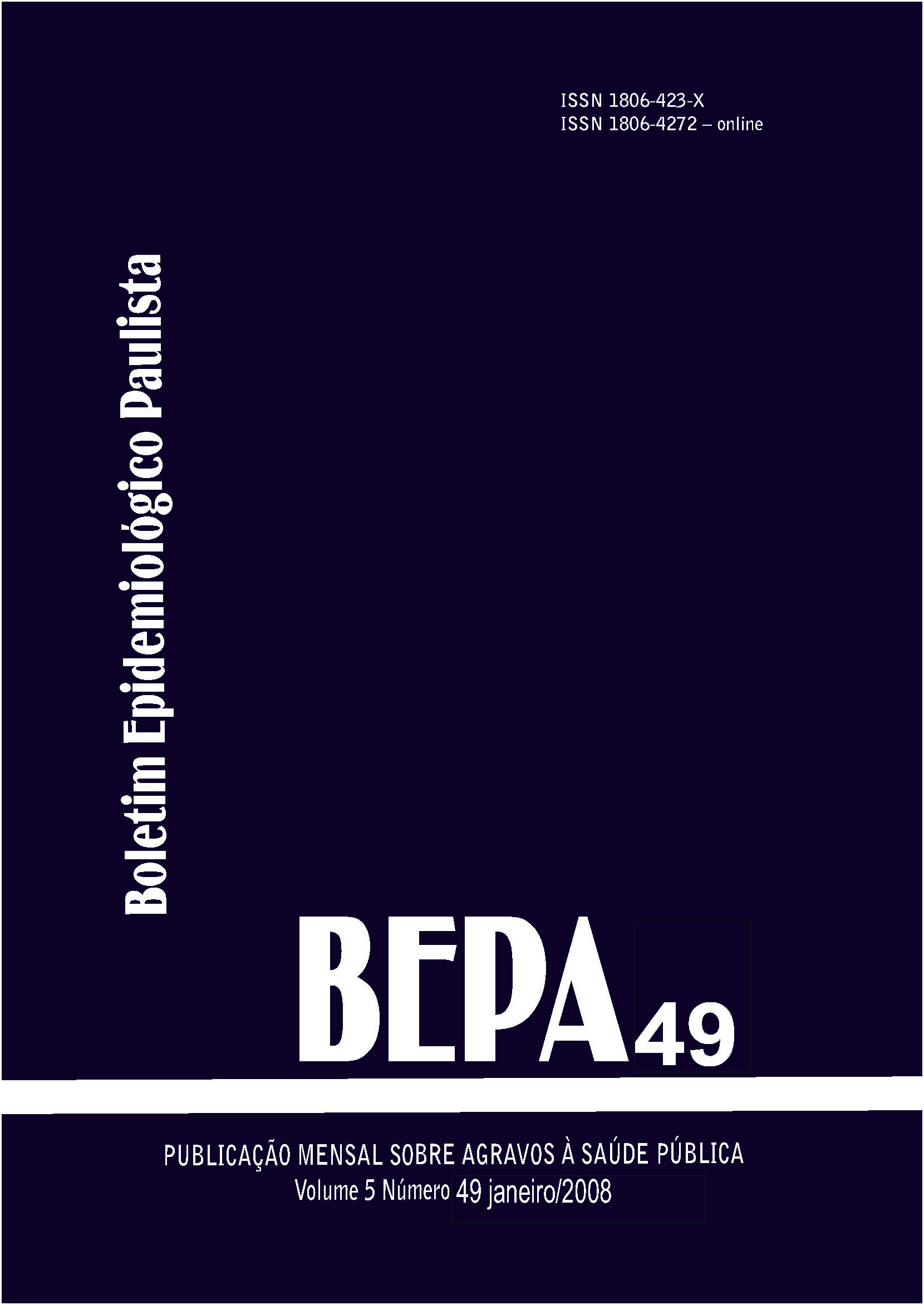Abstract
Cyclospora cayetanensis, an emerging coccidian parasite, acquired importance due to cause diarrhea outbreaks and sporadic cases worldwide associated with food. In Brazil, until 1999, no cyclosporiasis outbreak was registered. We summarize the findings of the Cyclospora cayetanensis outbreak investigation occurred from September to December 2000, in the city of General Salgado, SP, associated with the public drinking water system. A descriptive study was conducted to identify the source of transmission, including interviews with patients, data analysis of local diarrhea trends, sanitary inspections in water and sewer systems, as well as laboratorial tests of patients stool, suspected food and public drinking water samples. Compatible clinical case was defined as the person with liquid diarrhea and, at least, three other gastrointestinal symptoms such as nausea, vomit, flatulence, abdominal pain, weight loss or prolonged diarrhea, resident in General Salgado, during the period of the outbreak. Confirmed laboratorial cases were defined as those with typical oocysts in the stool sample. Clinical samples and food were analyzed by Adolfo Lutz Institute. Water samples were tested at the CDC/Atlanta, by PCR analysis. A total of 350 cases were identified as involved in this outbreak (incidence rate = 32.3 cases/1,000 inhabitants) and children under 4 years old were the group more affected (incidence rate = 49.1 cases/1,000 inhabitants). Among 40 cases tested for bacteria, virus and parasite, 10 were positive for Cyclospora cayetanensis. The water system was compound by 15 artesian wells with infiltration of pluvial water and sewer. The water from one of them (well # 7) was positive for Cyclospora cayetanensis. Control of this outbreak required important changes in public drinking water and sewer systems of the city. Educational measures, monitoring of acute diarrhea, laboratorial tests of all new cases of diarrhea, water quality control, during and after the reconstruction of the systems, contributed to eliminate the Cyclospora cayetanensis source of transmission. Six new sporadic cases were also reported during 2001. From 2002 to December 2007 no cases were identified.
References
Ortega YR, Gilman RH, Sterling CR. A new coccidian parasite (Apicomplexa: Eimeiidae) from humans. J Parasitol. 1994;80:625-9.
Centro de Vigilância Epidemiológica. Secretaria de Estado da Saúde de São Paulo. Ciclosporíase/Cyclospora cayetanensis. Manual de Doenças Transmitidas por Alimentos – Informe Net DTA [acessado em 16 de janeiro 2008]. Disponível em: http://www.cve.saude.sp.gov.br/htm/hidrica/ inf_cyclospora.htm.
Can KJ, Chalmers RM, Nichols G, O'Brien SJ. Cyclospora infections in England and Wales: 1993 to 1998. Commun Dis Public Health. 2000;3:46-9.
Döller PC, Dietrich K, Filipp N, Brockmann S, Dreweck C, Vonthein R, Wagner-Wiening C, Wiedennmann A . Cyclosporiasis outbreak in Germany associated with the consumption of salad. Emerg Infec Dis [serial on-Iine]. 2002 8 Sep [acessado em Jan 16 2008];. Disponível em: http://www.cdc.gov/ncidod/EID/vol8no9/ 01-0517.htm.
Herwaldt BL, Ackers ML. An outbreakin 1996 of cyclosporiasis associated with imported raspberries. The Cyclospora Working Group. N Engl J Med. 1997;336:1548-56.
Herwaldt BL, Beach MJ. The return of Cyclospora in 1997: Another outbreak of cyclosporisis in North America associated with imported raspberries. The Cyclospora Working Group. Annals of Internal Medicine 1999;130(3):210-20.
Centers for Disease Control and Prevention (CDC). Update: outbreaks of cyclosporiasis – United States and Canada, 1997. MMWR. 1997;46:689-91.
Centers for Disease Control and Prevention (CDC). Outbreak of cyclosporiasis – Northern Virginia – Washington, DC – Baltimore, Maryland, Metropolitan Area, 1997. MMWR. 1997;46:689-91.
Mohle-Boetani JC, Werner SB, Waterman SH, Vugia DJ. The impact health communication and enhanced laboratory-based surveillance on detection of cyclosporiasis outbreaks in California. Emerg Infec Dis. 2000; 6(2): 200-203.
Vilela DB, Alvarez GG, Carmo GMI. Surto de diarréia relacionada com alimentos: um estudo de caso-controle, General Salgado, SP, 1999-2000. Informe Net/DDTHA/CVE – 2000 [on-line]: slides. [acessado em 16 de janeiro de 2008] . Disponível em: ftp.cve.saude.sp.gov.br/doc_tec/hidrica/ dta_inqsurtosgs.ppt.
Centro de Vigilância Epidemiológica. Secretaria de Estado da Saúde de São Paulo. Moni tor ização das Doenças Diarréicas Agudas – Normas e Instruções. São Paulo: Secretaria de Estado da Saúde; 2002.
Zini RM, Santos CCM, Almeida IAZC, Peresi JTM, Marques CCA. Atuação do Laboratório de Saúde Pública na elucidação do surto de diarréia causado por Cyclospora cayetanensis no município de General Salgado – SP. Rev Inst Adolfo Lutz. 2004; 63(1): 116-121.
Puente S; Morente A; García-Benayas T; Subirats M; Gascón J; González-Lahoz JM. Cyclosporiasis: a point source outbreak acquired in Guatemala. J Travel Med. 2006;13(6):334-7.
Hoang LM; Fyfe M; Ong C; Harb J; Champagne S; Dixon B; Isaac-Renton J. Outbreak of cyclosporiais in British Columbia associated with imported Thai basil. Epidemiol Infect. 2005;133(1):23-7.
Botero-Garcés J; Montoya-Palacio MN; Barguil JI; Castaño-González A. Brote epidémico por Cyclospora cayetanensis en Medellín, Colombia. Rev Salud Publica. 2006;8(3)258-68.
Madico G, McDonald J, Gilman RH, Cabrera L, Sterling CR. Epidemiology and treatment of Cyclospora cayetanensis infection in Peruvian chi ldren. Cl in Infect Dis. 1997;24:977-81.
Ortega YR, Roxas CR, Gilman RH, Miller NJ, Cabrera L, Taquiri C, et al. Isolation of Cryptosporidium parvum and Cyclospora cayetanensis from vegetables collected in markets of an endemic region in Peru. Am J Trop Med Hyg. 1997;57:683-6.

This work is licensed under a Creative Commons Attribution 4.0 International License.
Copyright (c) 2008 Maria Bernadete de Paula Eduardo, Daniel B. Vilela , Graziela G. Alvarez, Greice M. I. Carmo, Márcia C.F.P. Reina, Vera R. T. Eid , Angela M. Vieira, Raquel P. Caldeira, Elaine R.S.S. Baldi, Arnaldo Mauro Elmec, Alexandre J. da Silva
